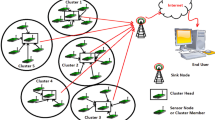Abstract
Recently energy-efficient duty cycle design for wireless sensor networks has become popular. In target-based applications, wireless sensors are deployed to monitor target points. In such networks, only a set of nodes are scheduled for monitoring and the remaining nodes are sent to sleep mode to conserve energy. Delay-aware mobile sink path, target coverage, and fault tolerance are very essential for energy-efficient data delivery in critical target applications. In the proposed work we aim to reduce the number of nodes scheduled for target coverage while ensuring complete coverage and connectivity through gathering points. The node selection for coverage is done by gathering points based on residual energy, node density, target coverage, and distance which are essential aspects for ensuring coverage and reducing energy consumption. Further, a delay-aware mobile sink trajectory is formed using the traveling salesman problem for data collection. Distributed fault recovery method is developed which ensures the recovery of orphan member node formed due to failure of Gathering points and rescheduling if a node fails while covering a target. The proposed method is compared with existing algorithms through simulations. Results show the efficiency of the proposed method called ETCAT in terms of network lifetime, energy consumption, packet delivery, and coverage. The proposed method has 17% better lifetime than the existing techniques.











Similar content being viewed by others
References
Aak S, Øvsthus K, Kristensen LM (2014) An industrial perspective on wireless sensor networks—a survey of requirements. Protoc Chall 16:1–22
Cardei M (2005) Energy-efficient target coverage in wireless sensor networks
Wang B (2011) Coverage problems in sensor networks: a survey. ACM Comput Surv. https://doi.org/10.1145/1978802.1978811
Demigha O, Hidouci W, Ahmed T (2013) On energy efficiency in collaborative target tracking in wireless sensor network: a review. IEEE Commun Surv Tutor 15:1210–1222
Cardei I, Cardei M (2002) Energy-efficient connected-coverage in wireless sensor networks
Mostafaei H, Meybodi MR (2013) Maximizing lifetime of target coverage in wireless. Wirel Pers Commun. https://doi.org/10.1007/s11277-012-0885-y
Chauhan V, Soni S (2019) Mobile sink—based energy efficient cluster head selection strategy for wireless sensor networks. J Ambient Intell Humaniz Comput. https://doi.org/10.1007/s12652-019-01509-6
Kumar V, Kumar A (2018) Improving reporting delay and lifetime of a WSN using controlled mobile sinks. J Ambient Intell Humaniz Comput. https://doi.org/10.1007/s12652-018-0901-5
Rao J, Biswas S (2010) Network-assisted sink navigation for distributed data gathering: Stability and delay-energy trade-offs. Comput Commun 33:160–175. https://doi.org/10.1016/j.comcom.2009.08.009
Kaur A, Ajay S, Neetu KS (2017) Enhancing coverage using weight based clustering in wireless sensor. Networks. https://doi.org/10.1007/s11277-017-5026-1
Sharmin S, Nur FN, Islam M (2019) Target coverage-aware clustering in directional sensor networks: a distributed approach. IEEE Access 7:64005–64014. https://doi.org/10.1109/ACCESS.2019.2916407
Islam M, Razzaque A, Hassan MM (2015) Target coverage through distributed clustering in directional sensor networks. EURASIP J Wirel Commun Netw. https://doi.org/10.1186/s13638-015-0394-2
Hanh NT, Le Nguyen P, Tuyen PT, Thi H, Binh T, Kurniawan E, Ji Y (2018) Node placement for target coverage and network connectivity in WSNs with multiple sinks
Yadav M (2019) A novel WSN protocol for increasing network life using combination of node ’ s positions and communication range. Int J Inf Technol. https://doi.org/10.1007/s41870-019-00358-y
Bongale AM, Arunkumar CRN (2020) Energy efficient intra-cluster data aggregation technique for wireless sensor network. Int J Inf Technol. https://doi.org/10.1007/s41870-020-00419-7
Soro S, Heinzelman WB (2009) Ad hoc networks cluster head election techniques for coverage preservation in wireless sensor networks. Ad Hoc Netw 7:955–972. https://doi.org/10.1016/j.adhoc.2008.08.006
Wang B, Lim H, Ma D, Yang D (2010) A coverage-aware clustering protocol for wireless sensor networks. Comput Netw. https://doi.org/10.1109/MSN.2010.19
Gu X, Yu J, Yu D, Wang G, Lv Y (2013) ECDC: an energy and coverage-aware distributed clustering protocol for wireless sensor networks q. Comput Electr Eng. https://doi.org/10.1016/j.compeleceng.2013.08.003
Jamali S, Hatami M (2015) Coverage aware scheduling in wireless sensor networks: an optimal placement approach. Wirel Pers Commun. https://doi.org/10.1007/s11277-015-2862-8
Liu D, Zhang J (2011) A multi-sink and multi-object tracking strategy for wireless sensor networks, pp 4273–4276
Chen G, Cheuh J, Sun M, Chiang T, Jeng AA (2015) Energy-efficient mobile targets detection in the presence of mobile sinks. Comput Commun 000:1–18. https://doi.org/10.1016/j.comcom.2015.08.015
Zhao Q, Member S, Gurusamy M, Member S (2008) Lifetime maximization for connected target coverage in wireless sensor. Networks 16:1378–1391
Chen C, Mukhopadhyay SC, Chuang C (2014) Efficient coverage and connectivity preservation with load balance for wireless sensor. Networks. https://doi.org/10.1109/JSEN.2014.2336257
Lee J, Member S, Choi B, Member S, Lee J (2011) Energy-efficient coverage of wireless sensor networks using ant colony optimization with three types of pheromones. IEEE Trans Ind Inform 7:419–427
Lee J, Member S, Lee J (2012) Ant-colony-based scheduling algorithm for energy-efficient coverage of WSN. IEEE Sens J 12:3036–3046
Almi K (2010) Energy-efficient data gathering with tour length-constrained mobile elements in wireless sensor networks, pp 582–589
Mishra M (2016) A delay-bound efficient path design algorithm for mobile sink in wireless sensor networks
Komal P, Nitesh K, Jana PK (2016) Indegree-based path design for mobile sink in wireless sensor networks. In: 2016 3rd International Conference on Recent Advances in Information Technology (RAIT), pp 78–82. https://doi.org/10.1109/RAIT.2016.7507879.
Yang Y, Lin T, Liu B, Chu S, Lien C, Pham V (2017) An efficient mobile sink scheduling method for data collection in wireless sensor networks. In: 2017 International Conference on System Science and Engineering (ICSSE), pp 554–557. https://doi.org/10.1109/ICSSE.2017.8030936.
Chen T, Du W, Chen J (2019) Energy-efficient data collection by mobile sink in wireless sensor networks. In: 2019 IEEE Wirel. Commun. Netw. Conf, pp 1–6. https://doi.org/10.1109/WCNC.2019.8886001
Nitesh K, Jana P (2017) Minimum spanning tree—based delay-aware mobile sink traversal in wireless sensor networks. Int J Commun Syst. https://doi.org/10.1002/dac.3270
Nitesh K, Kaswan A, Jana PK (2019) Energy density based mobile sink trajectory in wireless sensor networks. Microsyst Technol 25:1771–1781. https://doi.org/10.1007/s00542-017-3569-4
Author information
Authors and Affiliations
Corresponding author
Rights and permissions
About this article
Cite this article
Bhasgi, S.S., Terdal, S. Energy and target coverage aware technique for mobile sink based wireless sensor networks with duty cycling. Int. j. inf. tecnol. 13, 2331–2343 (2021). https://doi.org/10.1007/s41870-021-00794-9
Received:
Accepted:
Published:
Issue Date:
DOI: https://doi.org/10.1007/s41870-021-00794-9




